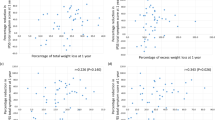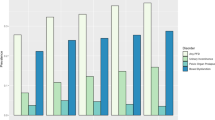Abstract
To determine if a relationship exists between patient body habitus and urinary incontinence after radical retropubic prostatectomy (RRP) for clinically localized prostate cancer. A questionnaire developed by combining parts of lower urinary tract symptom questionnaires concerning voiding symptoms after RRP was mailed to 268 consecutive patients who underwent RRP over a 2-year period. The interval between surgery and questionnaire administration was greater than 24 months for each patient. No interval was greater than 54 months. The questionnaire attempted to overcome the subjectivity of patient documented urinary incontinence by probing different aspects of each patient's voiding symptoms. Body mass index (BMI), obtained from preoperative anesthesia records, was used as the measurement for body habitus. Pearson correlations were used to determine relationships between BMI and responses and the independent t-test was used to determine differences between grouped responses and BMI. One hundred and eighty-two of 268 (68%) questionnaires were returned. No relationship was detected between BMI and patient estimates of urinary control, QOL relating to urinary symptoms, severity of stress incontinence, or use of protection (pad use). As well, no statistically significant relationship was found between BMI and a patient's willingness to undergo RRP again, based on his voiding symptoms, if given the choice. In conclusion, although patient body habitus may be related to other clinical outcomes following RRP, there does not appear to be a relationship of BMI to post-RRP urinary incontinence.
This is a preview of subscription content, access via your institution
Access options
Subscribe to this journal
Receive 4 print issues and online access
$259.00 per year
only $64.75 per issue
Buy this article
- Purchase on Springer Link
- Instant access to full article PDF
Prices may be subject to local taxes which are calculated during checkout
Similar content being viewed by others
References
Stephenson RA . Prostate cancer trends in the era of prostate-specific antigen: an update of incidence, mortality, and clinical factors from the SEER database. Urol Clin N Am 2002; 29: 173–181.
Eastham JA, Kattan MW, Rogers E, Goad JR, Ohori M, Boone TB et al. Risk factors for urinary incontinence after radical prostatectomy. J Urol 1996; 156: 1707–1713.
Fontaine E, Izadifar V, Barthelemy Y, Desgrippes A, Beurton D . Urinary continence following radical prostatectomy assessed by a self-administered questionnaire. Eur Urol 2000; 37: 223–227.
Gudziak MR, McGuire EJ, Gormley EA . Urodynamic assessment of urethral sphincter function in post-prostatectomy incontinence. J Urol 1996; 156: 1131–1135.
Hammerer P, Huland H . Urodynamic evaluation of changes in urinary control after radical retropubic prostatectomy. J Urol 1997; 157: 233–236.
Wei JT, Montie JE . Comparison of patients' and physicians' ratings of urinary incontinence following radical prostatectomy. Semin Urol Oncol 2000; 18: 76–80.
Jonler M, Madsen FA, Rhodes PR, Sall M, Messing EM, Bruskewitz RC . A prospective study of quantification of urinary incontinence and quality of life in patients undergoing radical retropubic prostatectomy. Urology 1996; 48: 433–440.
Mulholland TL, Huang RR, Peters KM . Radical prostatectomy patients with larger body mass are more likely to have positive apical margins and larger tumor volume. J Urol 2001; 165, Abstract 982, May.
Barry MJ, Fowler Jr FJ, O'Leary MP, Bruskewitz RC, Holtegrewe HL, Mebust WK, et al., the Measurement Committee of the American Urological Association. The American Urological Association symptom index for benign prostatic hyperplasia. J Urol 1992; 148: 1549.
Diokno AC, Brock BM, Brown MB, Herzog AR . Prevalence of urinary incontinence and other urological symptoms in the noninstitutionalized elderly. J Urol 1986; 136: 1022–1025.
Herr HW . Quality of life in incontinent men after radical prostatectomy. J Urol 1994; 151: 652–655.
Kassirer JP . Adding insult to injury. Usurping patients' prerogatives. New Eng J Med 1983; 308: 898–901.
Walsh PC, Marschke P, Ricker D, Burnett AL . Patient-reported urinary continence and sexual function after anatomic radical prostatectomy. Urology 2000; 55: 62–67.
Donnellan SM, Duncan HJ, MacGregor RJ, Russel JM . Prospective assessment of incontinence after radical retropubic prostatectomy: objective and subjective analysis. Urology 1997; 49: 225–230.
Litwin MS, Melmed GY, Nakazon T . Life after radical prostatectomy: a longitudinal study. J Urol 2001; 166: 587–592.
Bates P, Bradley W, Glen E, Melchior H, Rowan D, Sterling A et al. Fifth Report on the Standardization of Terminology of Lower Urinary Tract Function. Quantitation of Urine Loss. International Continence Society Committee for Standardization of Terminology: Bristol, 1983.
Talcott JA, Rieker P, Clark JA, Propert RJ, Weeks JC, Beard CJ, et al. Patient reported symptoms after primary therapy for early prostate cancer: results of a prospective cohort study. J Clin Oncol 1998; 16: 275.
Author information
Authors and Affiliations
Corresponding author
Appendix A
Appendix A
Beaumont Urinary Symptoms after Prostatectomy Survey
Thank you for assisting us in our study of prostate cancer. This survey should take only a short amount of time to complete. Men without any uncontrolled urine loss will only complete sections A and B. It is important for our study for you to answer all of the applicable questions. This is strictly confidential. If you have any questions, call (XXX) XXX–XXXX).






Thank you for completing this survey. All information will strictly be confidential. With your help, we can continue to learn more about prostate cancer and prostate cancer surgery.
Rights and permissions
About this article
Cite this article
Mulholland, T., Huynh, P., Huang, R. et al. Urinary incontinence after radical retropubic prostatectomy is not related to patient body mass index. Prostate Cancer Prostatic Dis 9, 153–159 (2006). https://doi.org/10.1038/sj.pcan.4500860
Received:
Accepted:
Published:
Issue Date:
DOI: https://doi.org/10.1038/sj.pcan.4500860
Keywords
This article is cited by
-
Factors Predicting Early Return of Continence After Radical Prostatectomy
Current Urology Reports (2010)
-
The impact of obesity on prostate cancer
World Journal of Urology (2007)



